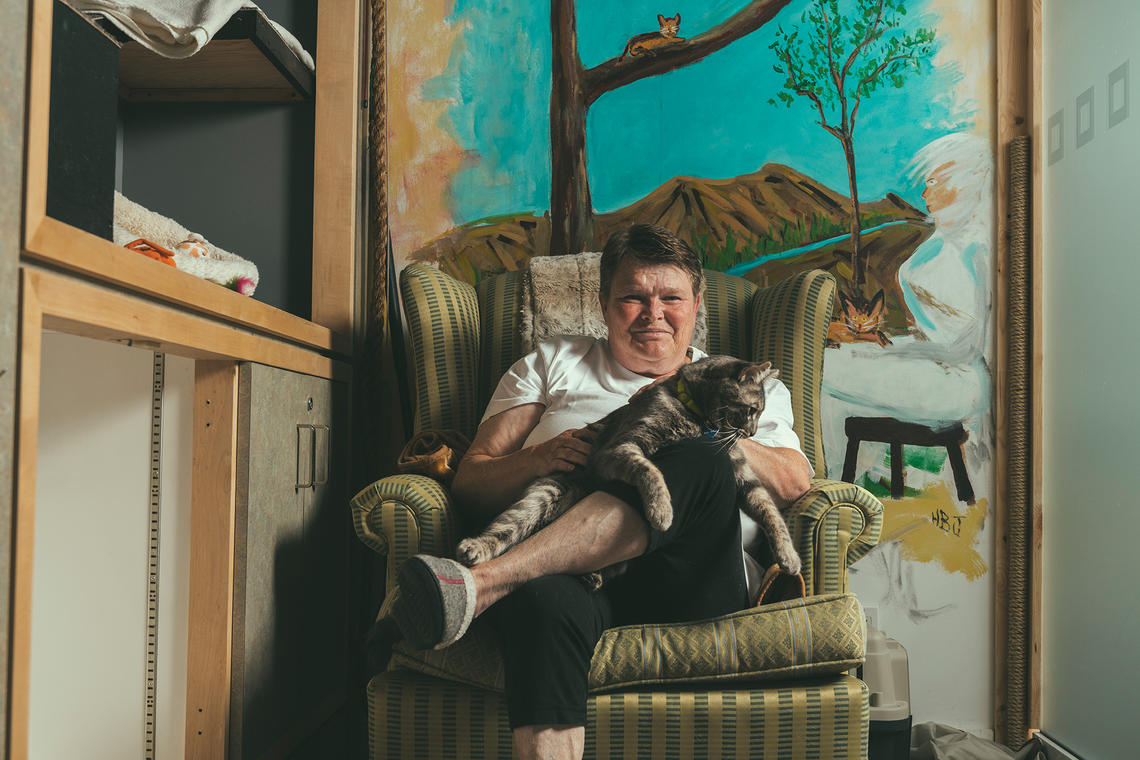
Better Aging with Pets
Jellybean is a dream roommate. He’s quiet and fun and never argues. He and Stan Parsons have lived together for nearly eight years, most recently in a small, sunny basement suite in Crescent Heights. Parsons spends a lot of time talking to Jellybean (a golden retriever), and to his cat, Kitcat. “They’re good company and Jellybean gets me out every day to exercise and talk to people in the park,” he says.
Parsons, 86, says he feels in his gut that, given his age and isolated living situation, having companion animals is good for him. Science backs him up: in the 1980s, University of Pennsylvania researchers confirmed the positive effects that pets have on everything from lowering blood pressure to allaying anxiety. And, earlier this year, the World Health Organization acknowledged the positive influence of animal companions on the health and well-being of adults later in life.
But, for many seniors living alone or in congregate-care settings, healthy pet-ownership can pose insurmountable financial and physical challenges. Indeed, just when an individual might benefit most from animal companionship, increased obstacles stand in the way of such a relationship. Vet bills and grooming can be prohibitively expensive; walking a dog may be an overwhelming prospect, if not physically impossible in some cases due to mobility limitations; and there’s fear that a beloved pet might be abandoned if the owner has to move to a non-pet-friendly residence, or the pet outlives its owner.
If having an animal companion makes people feel better and prospectively support their health, shouldn’t such partnerships have a bigger place on the age-friendly agenda? University of Calgary researcher and adjunct assistant professor Dr. Ann Toohey believes so.
Toohey, MSc’12, PhD’18, manages UCalgary’s Brenda Strafford Centre on Aging in the O’Brien Institute for Public Health and is focused on ways that people’s circumstances as they age shape how human-animal relationships unfold.
According to Toohey, 40 per cent of Canadian adults between the ages of 65 and 69 have a pet; that number drops to a still fairly significant 22 per cent for adults aged 80 and older. Her research underscores the need for leaders, planners and architects to consider new ways to create more age-friendly communities that might include better availability of appropriate housing, and policy changes that are more socially inclusive to older adults and their pets. “I’m interested in exploring the increased barriers that some older adults face with pets later in life — and that brings up issues around ethics and social justice,” Toohey says.
One of the questions at the heart of Toohey’s work is, “How can we support people who are struggling to keep their pets in ways that end up cancelling the benefits?” For instance, an older senior might not disclose their own declining health to their doctor because they fear losing their pet. Anxiety about paying for pet food, etc., likewise precludes the benefits of having a companion animal.
The focus of one of Toohey’s research projects is a novel social service program called Pet Assist. Delivered by the Calgary Seniors Resource Society, Pet Assist consists of a team of volunteers who help the most disadvantaged isolated seniors with pet care, from walking and administering medication to driving an animal to the veterinarian. “It’s a really important initiative because it not only provides social interactions, but keeps pet situations from getting out of control when an older person can no longer care for an animal on their own,” says Toohey.
Another new area of Toohey’s research is robotic pets in care settings for people with dementia. She’s currently part of an interdisciplinary research team investigating the ethical implications of introducing robotic pets as alternative companion animals for those who can’t care for a true pet, but “who may experience these entities as if they were alive.”
Toohey’s contributions to informing policy frameworks for age-friendlier cities has begun to raise awareness that human-animal relationships are shaped by social and physical environments — in other words, she and her team are discovering ways to give older people and their companion animals a better shot at experiencing a relationship with all the health benefits and far less stress.
That’s good news for Jellybean and his loyal human-friend.
Stan Parsons with Jellybean and Kitcat

Bryce Meyer
A couple of years ago, through a series of minor unfortunate events, Stan Parsons found himself in need of new rental housing — a tall order for an 86-year-old with a small budget and a large dog. He acquired his current digs when a homeowner saw him on the news making a plea for more pet-friendly affordable-housing options “I’ve had dogs just about all my life,” says Parsons, who has lived alone for more than a decade. He says that, were it not for his golden retriever, Jellybean, getting him out the door, he’d “stay in and watch the idiot box and curse at Donald Trump. I don’t know what I’d do without him.”
Greg Grant with Yogi

Bryce Meyer
Persuaded by their son to get a dog — specifically, a Shiba Inu (a breed now nearly impossible to get thanks to the absurdly popular “Doge” meme) — Greg, 73, and Judy Grant adopted Yogi as a tiny pup eight years ago. When Judy passed away in 2019, the dog became a lifeline for Greg. “I wouldn’t have gotten a dog on my own,” he says. “But, since I already had Yogi, well, that really made a difference for me.” Greg hadn’t ever cooked much for himself, but having to care for a dog demanded commitment to meal routine: “Yogi likes mac ’n’ cheese and sausages, so I started cooking for both of us.” Not only that, but Yogi’s need for daily, energetic walks forced his owner out into his Arbour Lake mobile-home community where Greg falls easily into conversation with fellow dog-walkers. “I tend to sit and read in the evening, but getting out with Yogi makes me see people I wouldn’t otherwise and that’s good,” he says.
Phyllis Humphrey with Kiwi

Bryce Meyer
For 19 years, Phyllis Humphrey and her cat, Miss Maggie Mae, had a good thing going. “She was my baby girl and my security blanket,” says Humphrey, 57, who noticed a decline in her physical and mental health after her beloved cat died two years ago. Indeed, her mental-health issues recently required her to move from an independent apartment into a seniors’ facility. That was a tough move for Humphrey, but things got better when Silvera for Seniors staff asked for her input in creating a communal “cat room” for residents. “That was so exciting,” says Humphrey. “I was included in a meeting with the Calgary Humane Society who provides cats for us.” A tiny, glassed-in space with cat climbers and a comfy chair gives one resident at a time an opportunity to play and cuddle with a cat until they’re adopted. “I just feel better when I hold her and play with her,” says Humphrey.
Donna Bottoms with Holly

Bryce Meyer
Rescued from a high-kill shelter in California, Holly — a miniature poodle-Bichon-Frise mix — eventually found her new home in northwest Calgary with Donna Bottoms, despite a number of potential obstacles. “I really worried about vet bills and grooming costs, and I still do,” says Bottoms, who, at 73, has lived alone since her husband died 25 years ago. “Not only that, but I was concerned about getting a dog that might outlive me.” Bottoms confessed her worries to her son, who told her he would help out where needed, and also take the dog should his mom die before Holly. “That was big for me,” she says. Reassured, Bottoms allowed herself to fall for her little companion who, she says, “gets me out for a daily romp and who looks at me funny when I talk to her all day long. I’d be very lonely sitting here all day without her.”
Fahreen Nathoo with Kiwi (no relation to the other Kiwi), the Hasbro Joy for All Companion Pet

Bryce Meyer
Fahreen Nathoo is the wellness co-ordinator at southwest Calgary’s Staywell Manor Village. She works with a team to ensure residents’ wellness and comfort on a day-to-day basis. “We’re looking for behavioural changes, anxiety, confusion, restlessness — and, in conjunction with medication-management, we use creativity to intervene when we can. That’s where the cat comes in.” Kiwi purrs, meows and seemingly enjoys having her belly scratched. Nathoo says that, for some residents in the assisted living suites, agitation subsides when they pet Kiwi. “Kiwi is a helper; that’s how I think of her,” she says.
Stella Massey-Hicks with Thomas and Tucker

Bryce Meyer
Stella Massey-Hicks, 90, grew up in South Africa where she had a dog as a child. “I’ve always absolutely adored dogs,” she says. Funny, sweet and sharp, Massey-Hicks is experiencing memory loss, but she never forgets to take her stuffed pets wherever she goes . “My daughter bought them for me, and I think they’re so cute, I really love having them,” she says. “Everyone enjoys them.” Sometimes, she worries they might go missing and she appreciates the staff’s attentiveness to keeping them safely tucked away when they’re not in Massey-Hicks’ lap. “I love them because, when I’m feeling lonely, I want them with me,” she says. “They bring out tenderness and loving thoughts and feelings, and that’s very admirable.”
How ethnically diverse are older Canadian pet-owners?
The truth is, we don’t really know. As our increasingly diverse population ages, researchers are learning more and more about the complex relationship between ethnicity and pet ownership
By Dr. Ann Toohey, PhD
In 2020, just shy of 60 per cent of Canadians reported that their household included at least one dog or cat. Based on my analysis of a nationally representative sample of older adults participating in the Canadian Longitudinal Study on Aging (CLSA), I have found that 33 per cent of older Canadian adults report having a companion animal (which, I assume, will primarily be a cat or dog).
In this same study, I also found that 23 per cent of older participants who identified as a visible minority reported having a pet, compared with 33 per cent of those who identified as being White. As an important consideration, however, the CLSA sample under-represents members of visible minority populations who are recent immigrants, and especially those who were born in Asia. Therefore, 23 per cent is likely not an accurate estimate, given that CLSA participants had to be able to conduct the data collection survey in either English or French language.
In a different component of my research, I recruited older Calgarian pet-owners representing a wide range of household incomes. My aim was to begin to better understand ways that income and social support may shape ways that older adults experience both benefits and challenges of pets later in life. I saw two marked trends in my study participants: nearly all of the older adults who contacted me lived alone with their pet(s), and none belonged to a visible minority population.
These trends raise some interesting questions. For instance, what are the pet-keeping practices of older Canadians who identify as visible minorities? How are these shaped by immersion in the dominant Canadian culture, where keeping dogs and cats is so prevalent? How might pet-keeping practices change as second-generation Canadians reach the age of 65 years and beyond? And are there links between pet-ownership, social isolation and different cultural practices when it comes to ways that we support our loved ones later in life?
Undoubtedly, the relationship between ethnicity and pets is a complex one. We know that having pets is an international phenomenon, yet there is much we don’t yet know in relation to our increasingly diverse, aging Canadian population. Improved understanding of this phenomenon will help to inform animal welfare and social-service organizations that recognize the health-promoting potential of relationships that many older Canadians have with pets.

